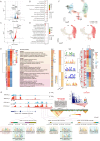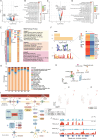A pilot multi-omics study reveals genetic mechanisms regulating milk component traits in dairy cattle
- PMID: 40760047
- PMCID: PMC12322288
- DOI: 10.1038/s42003-025-08615-6
A pilot multi-omics study reveals genetic mechanisms regulating milk component traits in dairy cattle
Abstract
Milk protein percentage (PP) and fat percentage (FP) are important indicators for measuring milk quality, but only a few causative genes such as DGAT1, GHR, and ABCG2, have been identified, indicating substantial potential for further exploration. Here, we integrated genotyping, RNA-seq, ATAC-seq, single-cell atlas and cis-QTLs datasets from the liver and mammary gland to investigate their genetic regulation. We identified cell type affecting milk composition, such as HPE2 and LumSec-HSPH1, and highlighted nine candidate genes (EFNA1, ERBB3, DUSP16, DEPTOR, TRIM46, HSTN, CIDEA, ACACA and SPP1) that are involved in the regulation of milk protein and fat synthesis through MAPK, AMPK, PI3K-Akt, and mTOR signalling pathways. Notably, EFNA1 was consistently identified across all omics analyses, showing increased promoter accessibility in the high PP group, potentially driven by CTCF and RXRA-mediated transcriptional activation. Overall, this study reveals potential cell types, candidate genes, and regulatory mechanisms influencing milk composition, offering insights to support milk quality improvement. The limited sample size represents the main constraint of this work, and future efforts will focus on population-scale genetic analyses and wet-lab validation.
© 2025. The Author(s).
Conflict of interest statement
Competing interests: The authors declare no competing interests.
Figures






Similar articles
-
Soybean isoflavone promotes milk yield and milk fat yield through the ERα-mediated Akt/mTOR pathway in dairy goats.J Anim Sci. 2024 Jan 3;102:skae352. doi: 10.1093/jas/skae352. J Anim Sci. 2024. PMID: 39657106
-
Sequence-based GWAS reveals genes and variants associated with predicted methane emissions in French dairy cows.Genet Sel Evol. 2025 Jun 17;57(1):32. doi: 10.1186/s12711-025-00977-z. Genet Sel Evol. 2025. PMID: 40528185 Free PMC article.
-
HSF1 and CPSF1 affect milk fat and protein synthesis by regulating the AKT/mTOR signaling pathway.J Anim Sci. 2025 Jan 4;103:skaf009. doi: 10.1093/jas/skaf009. J Anim Sci. 2025. PMID: 39932399
-
Milk proteins as mastitis markers in dairy ruminants - a systematic review.Vet Res Commun. 2022 Jun;46(2):329-351. doi: 10.1007/s11259-022-09901-y. Epub 2022 Feb 23. Vet Res Commun. 2022. PMID: 35195874 Free PMC article.
-
Invited review: Somatotropin and lactation biology.J Dairy Sci. 2025 Jul;108(7):6538-6549. doi: 10.3168/jds.2024-26177. Epub 2025 Mar 24. J Dairy Sci. 2025. PMID: 40139351 Review.
References
-
- Aschenbach, J. R., Kristensen, N. B., Donkin, S. S., Hammon, H. M. & Penner, G. B. Gluconeogenesis in dairy cows: the secret of making sweet milk from sour dough. IUBMB Life62, 869–877 (2010). - PubMed
-
- Rawson, P. et al. Metabolic proteomics of the liver and mammary gland during lactation. J. Proteom.75, 4429–4435 (2012). - PubMed
-
- Grisart, B. et al. Positional candidate cloning of a QTL in dairy cattle: identification of a missense mutation in the bovine DGAT1 gene with major effect on milk yield and composition. Genome Res.12, 222–231 (2002). - PubMed
MeSH terms
Substances
LinkOut - more resources
Full Text Sources
Research Materials
Miscellaneous

